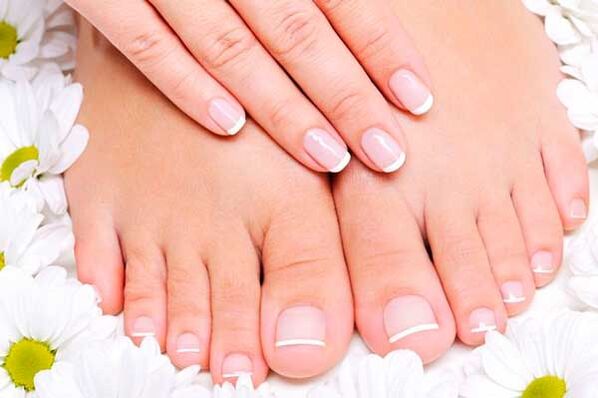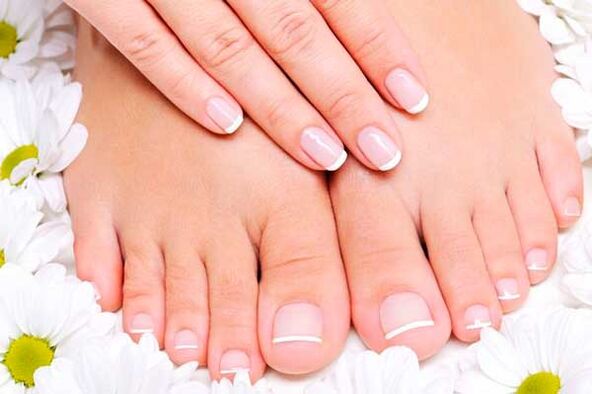
Nail fungus is the most common and most unpleasant disease. A fungal infection of the feet and nails cannot cause significant damage to health, but it causes a weakening of the immune system and unpleasant painful sensations.
Toenail fungus is able to concentrate poisonous toxins in the body, which multiply during the growth of pathogenic fungi, resulting in a slow poisoning of the body, can cause an allergic reaction or aggravate chronic diseases. As a result, metabolic processes in the body are disturbed, immunity decreases, the general physical condition worsens, and sensitivity to various negative environmental influences increases.
In this article, you will learn what fungal spores are, the causes of this unpleasant disease, symptoms and signs of damage, how to treat nail fungus at home, what preventive measures to take to avoid infection.
Why does fungal mycosis occur on toenails?
A fungal infection can cause:
- sores on the feet in the form of cracks and abrasions, which can be the result of a pedicure procedure or wearing uncomfortable, narrow shoes;
- corns and calluses on the feet;
- irregular foot care;
- decreased immunity;
- prolonged use of antibiotics and similar drugs in effect on the body during treatment;
- excessive sweating of the foot;
Decreased immunity and protective functions of the body can trigger a fungal disease, but they are not the main factor in the onset of the disease.
First of all, the infection occurs:
- domestic way of contact with a sick person, most often a close relative, through slippers or ordinary shoes, through household items - cloths, sponges, rugs;
- in the sauna, bath, pool and on the beach. A large crowd of people and a humid environment contribute to the spread of fungal diseases;
- anywhere where people walk without shoes. The fungus spores are able to withstand sudden changes in temperature from low to very high and remain for a long time in the sand, on the surfaces of the sidewalks, on the upper surfaces of the pool;
- when wearing someone else's shoes, in which pathogenic viral microflora can live and multiply;
- wearing socks or socks made of synthetic materials that do not allow the passage of air create a microclimate favorable to fungal infection;
- the constant use of false nails makes it impossible for the nail plate to breathe, which also contributes to mycosis infection;
Symptoms of Fungal Infection of Nails and Feet
- dryness, itching, redness and scaling of the feet;
- the appearance of small itchy blisters on the sole and between the toes, the formation of calluses is possible;
- the appearance of diaper rash on the legs due to increased perspiration;
- change in nail shape and color. The fungus spores penetrate the nail plate and gradually take root there. The nail structure becomes heterogeneous, brittle, with an uneven surface. In places of defeat, light or yellow spots and voids appear under them;
- under the influence of poisonous toxins produced by fungal spores, the legs sweat a lot, an unpleasant, sharp odor appears;
- increase in body temperature is possible.
If there are cracks, itchiness, diaper rash, an unpleasant foot odor, a change in the shape of the nail, and the appearance of white or yellow spots on its surface and voids underneath, there is a direct reason to contact a dermatologist for detailed advice and a regimen. of treatment. The dermatologist will tell you everything about treating mycosis of the toenail at home and will prescribe appropriate medicines for each specific case, as well as giving advice on the use of traditional medicine.

The symptoms of the disease and the nature of the lesion depend on the type of ringworm fungus:
- type of ringworm - vesicular, begins to affect the bottom of the foot, is characterized by the appearance of small blisters and blisters filled with fluid and additional attachment of bacteria - pathogens;
- type of ringworm - membranous, characterized by the appearance on the skin between the fingers of small rashes of a red rash and the appearance of painful cracks;
- ringworm type - moccasin type, in which ringworm affects the skin of the foot, starting at the heel and ending at the toes. The lesion is accompanied by painful sensations, the skin of the foot thickens, cracks and itching appear.
Most often, fungus spores from the sole of the foot pass to the nail plates, the fungus takes root and grows on the nail, affecting it. A fungal infection negatively affects the entire body, inhibits its functions and can cause allergic reactions.
Treatment of toenail fungus at home: preparations against mycoses
The most effective treatment for toenail fungus at home is a complex combination of special drugs against ringworm and folk remedies. First, we will talk about what drugs are used in the treatment of toenail fungus, then on popular methods.
Medications must be used strictly as directed, dosing them consistently and accurately. For the treatment of ringworm, there are special antimycotic drugs in the necessary dosages. With advanced cases and extensive lesions, the fungus can be eliminated in several stages, with a certain temporary pause between courses of treatment.
It is possible to cure a fungus with a medical method with the help of cheap and very effective medicines. Means against ringworm are available in the form of ointment, gel and varnish, which must be applied to the surface of the nail several times a day. The spores of the fungus are very resistant to various influences on it, in order to completely get rid of it, you will have to periodically change the drug treatment regimen and switch between medicines and traditional medicine.
Treatment of toenail fungus with folk remedies at home
Treating toenail fungus with folk remedies at home is a periodic treatment of fungal affected areas with special natural remedies. It is known that ringworm is afraid of acid, and the treatment of the fungus with the help of nature is based on this fact. The most effective natural remedies are vinegar, hydrogen peroxide, propolis, baking soda, iodine, garlic, kombucha. These are just the means that negatively affect the pathogenic flora of the fungus and are able to cope with it.
Toenail Fungus Treatment with Vinegar
Vinegar treatment is carried out with lotions with a specially made composition of vinegar, alcohol and glycerin. The proportions of the proportion of the components are taken in the appropriate amounts -2/2/1. A piece of cotton wool or a cotton pad soaked in a solution is applied to the nail plate affected by the fungus and kept for a certain time, then the feet must be dried with a clean towel or napkin and only after a while rinse the feet with warm water. Lotions should be applied from two weeks to a month, depending on the complexity of the injury. In the process of such treatment, the infected nail begins to exfoliate and gradually disappears, and a new healthy nail grows in its place.
Important! To avoid burning the skin around the diseased nail, it is recommended to lubricate the skin with any vegetable oil before applying the lotion.
Treating Nail Fungus with Baking Soda
Baking soda treatment is carried out in the same way as with vinegar, for this you need to make a cold solution of baking soda, soak a cotton pad and place it on the affected nail for a while, then remove the disc and clean the nail well with a dry towel.
Hydrogen peroxide against nail fungus
Treatment with hydrogen peroxide is carried out as follows: peroxide must be poured into the voids under the nail plate, where the fungus has taken root. The aggressive and disinfecting environment of peroxide perfectly destroys the spores of fungi and helps to quickly get rid of the disease.
Iodine
A good effect is given by iodine treatment, which must be applied to the nail plate several times a day, and fungal cavities must also be treated with iodine.
Propolis
In the treatment of fungi with propolis, compresses of tincture of propolis and alcohol help well. The compresses should be applied daily and kept for a certain time, then rinse the feet with warm water. Such treatment should be carried out until a positive result occurs and the nail is renewed.
Other popular methods of treating nail fungus
- Another effective but somewhat complicated recipe is to apply a mixture of a teaspoon of methyl phthalate, a tablespoon of vinegar, a teaspoon of vegetable oil and two raw eggs to the affected area. Mix all components well and keep in the fridge until complete use. Apply a compress of the mixture to the nail, wrap your finger with plastic wrap, put a wool sock on top. Hold for at least thirty minutes.
- As a homeopathic remedy, a living organism, Kombucha, helps a lot. Throughout the night, place a piece of kombucha on the affected nail and cover that spot with plastic wrap. Kombucha has an acidic environment and handles mold spores well.
- A good result is obtained by daily treatment of the affected surface with finely grated garlic. Garlic juice is a natural disinfectant and works great for mold spores.
Treating toenail fungus at home should be carried out regularly and methodically. If a microscopic proportion of spores remains under the nail, the fungus will start to grow again and the entire treatment will have to be started all over again.
To avoid infection with a fungus of the toenail and skin of the feet, you need to follow preventive measures, which we will talk about later.
Disease prevention
- To avoid primary infection or reinfection with ringworm, it is necessary to regularly process all manicure tools and accessories. If the manicure or pedicure procedure takes place in a beauty salon, then make sure that the master does not use tools that have not been processed after someone else.
- Periodically clean your shoes with disinfectants like vinegar or formaldehyde. To obtain the best therapeutic effect in disinfecting shoes, mix these products well together and carry out the treatment.
- From time to time, disinfect common household and household items by boiling them in a soapy solution. For the solution, a combination of water, washing powder, and a small amount of baking soda is best;
- Bath, sauna and visit to the pool only in rubber flip-flops or special flip-flops.
- Have individual bath accessories - washcloth, sponge and towel.
- Regularly observe foot hygiene with the help of water procedures. Whenever possible, make foot baths with warm water, in which it is good to add a crystal of potassium permanganate or a teaspoon of baking soda as a disinfectant.
- Do not try on, much less wear someone else's shoes, as they are considered the best carriers of fungal diseases.
Successful treatment of toenail fungus at home is possible only if all the recommendations of a dermatologist are followed, with strict adherence to the treatment regimen and use of drugs, careful observation of the cleanliness of the lesions and regular performance of all treatment procedures. disinfection needed. It is imperative to follow preventive measures and be patient, as nail fungus is an insidious and intractable disease.
























